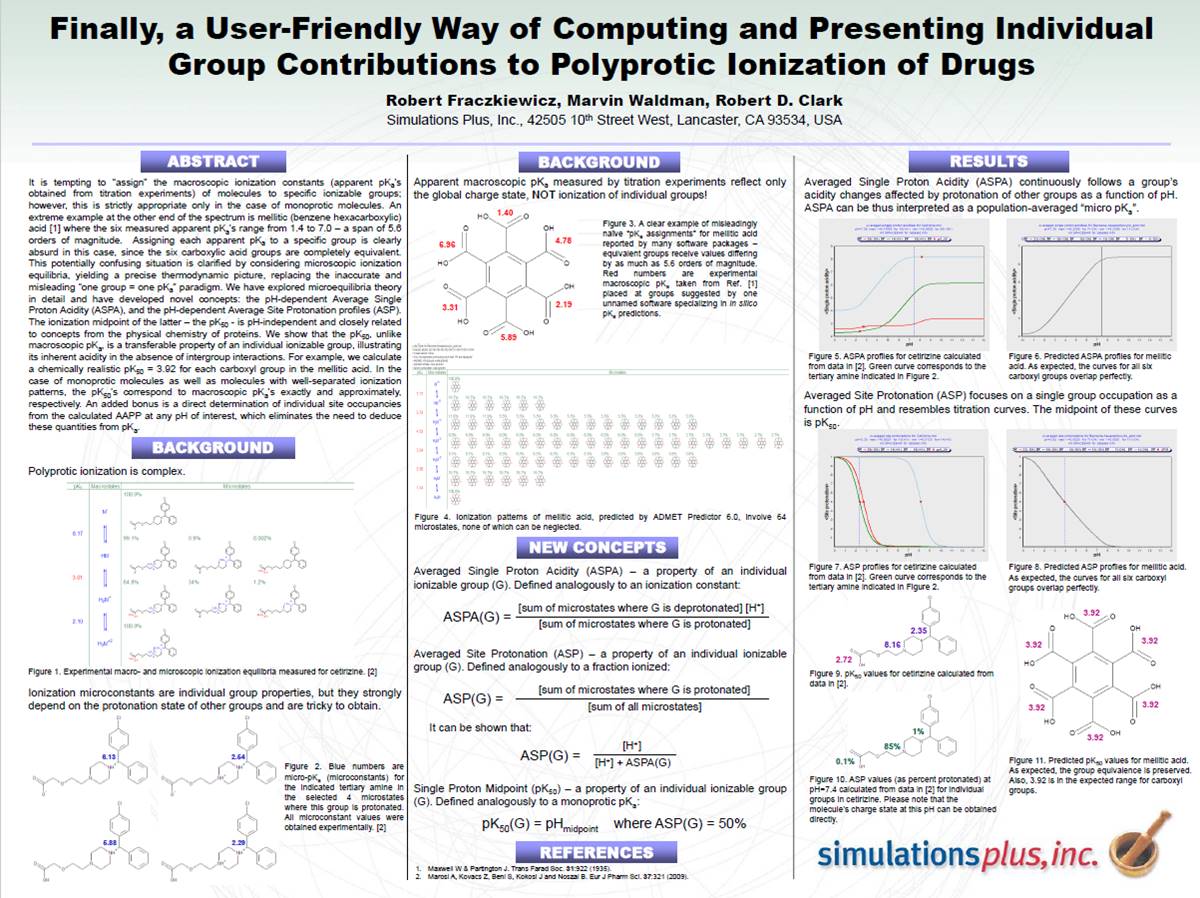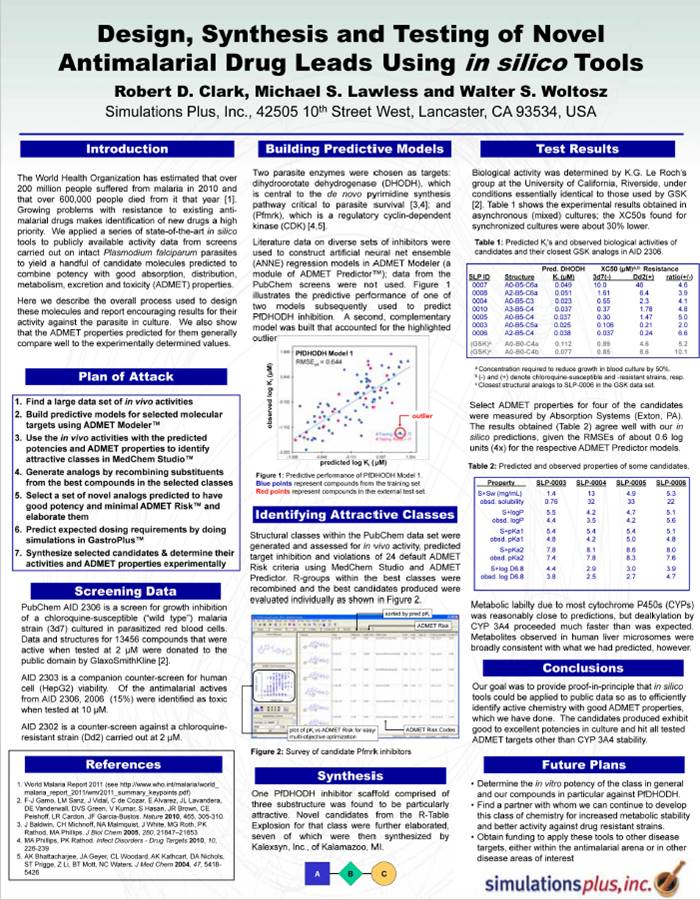The World Health Organization has estimated that over 200 million people suffered from malaria in 2010 and that over 600,000 people died from it that year [1]. Growing problems with resistance to existing anti…

PBPK Model Simulation of CYP3A4 and Transporter Mediated Drug-drug Interactions Involving Erythromycin
Erythromycin, a macrolide antibiotic, is cleared primarily by cytochrome P450-3A4 metabolism to the N-demethylated metabolite and C-formaldehyde. Its uptake into hepatocytes is mediated by organic…

Novel Antimalarial Drug Candidates Generated in silico by Analysis of Public HTS Data
Carry out a prospective experiment to demonstrate the ability of in silico drug design tools to design new lead drug candidates from phenotypic screening data.

Prediction of Amoxicillin Pharmacokinetics in Populations with Altered Renal Function
Purpose of the study was to predict amoxicillin pharmacokinetics in populations with altered renal function to further validate an absorption/PBPK model for amoxicillin.

Physiologically Based Pharmacokinetic (PBPK) Modeling of Amoxicillin Absorption and Pharmacokinetics
Purpose of the study was to develop a PBPK model for amoxicillin incorporating saturable transport processes affecting the drug’s absorption and distribution.

PBPK Modeling of Erythromycin Absorption and Disposition Mediated by Transporters in Humans
Erythromycin, a macrolide antibiotic, is cleared primarily by cytochrome P450-3A4 metabolism. Its uptake into enterocytes and hepatocytes is mediated by organic anion transporter (OAT) and organic anion…

In Silico Metabolite Prediction Using Artificial Neural Network Ensembles
Drug metabolism plays a crucial role in understanding bioavailability and drug-drug interactions, as well as in the design of prodrugs and in avoiding undesirable toxic metabolites.

Modeling of Furosemide in DILIsym™ Model Reveals Testable Hypotheses about Hepatotoxicity Mechanisms
A predictive, quantitative, mathematical model (DILIsym™) is under development as a public-private initiative based on the physiological processes involved in drug-induced liver injury. The model includes…

Finally, a User-Friendly Way of Computing and Presenting Individual Group Contributions to Polyprotic Ionization of Drugs
It is tempting to “assign” the macroscopic ionization constants (apparent pKa ‘s obtained from titration experiments) of molecules to specific ionizable groups; however, this is strictly appropriate only…

Physiologically-Based Pharmacokinetic (PBPK) Model for Prediction of Midazolam Pharmacokinetics After Intranasal Administration in Children
To predict midazolam absorption and pharmacokinetics (PK) after intranasal (i.n.) administration in young children. The absorption and PK of midazolam were simulated using GastroPlus™. The program’s…

Physiologically-Based Pharmacokinetic (PBPK) Models for Prediction of Saquinavir Effect on Midazolam Pharmacokinetics
Physiologically-based pharmacokinetic (PBPK) models for prediction of saquinavir effect on midazolam pharmacokinetics
Viera Lukacova, Walter S. Woltosz, Michael B. Bolger

Translating Disposition of Sotalol from Healthy Adults to Predict Its Behavior in Pediatric and Adult Subjects with Enhanced and Diminished Renal Clearance
To extend a physiologically based pharmacokinetic (PBPK) model of sotalol developed in healthy adults to predict its behavior in pediatric subjects and adults with varying degrees of renal clearance…

A Pharmacokinetic and Safety Evaluation of Single Oral Doses of Eszopiclone in Pediatric Subjects from 6 to 17 Years of Age with Attention Deficit Hyperactivity Disorder and Insomnia
Eszopiclone is a single-isomer, nonbenzodiazepine, cyclopyrrolone agent that has demonstrated efficacy with both polysomnography (PSG) and patient-reported measures in non-elderly adults with chronic primary…

Grouping Pharmacokinetic Profiles Using Kohonen Self-Organizing Maps
The shapes of plasma concentration versus time (Cp-time) profiles from large clinical trials are often highly variable, even in well-controlled trials involving homogeneous cohorts.

Transporter-Based in vitro-in vivo Extrapolation (IVIVE)
The use of in vitro data to predict the pharmacokinetics (PK) of drugs whose disposition is mediated by transporters is complicated due to unknown transporter expression levels in individual tissues both…

Pharmacokinetic (PK) And Pharmacodynamic (PD) Modeling Of Subcutaneous (Sc) Ly2189102, A Neutralizing IL-1 Beta Antibody, In Patients With Type 2 Diabetes Mellitus
LY2189102, a humanized neutralizing IL-1β antibody, was studied in type 2 diabetes mellitus (T2DM) patients with C-reactive protein (CRP) ≥ 2 mg/L, who received weekly subcutaneous doses of LY2189102…

Simulation of Tobramycin Pharmacokinetics After Topical Ophthalmic Administration
Tobramycin belongs to the class of aminoglycoside antibiotics. It does not bind to serum proteins [1], is eliminated mainly by renal secretion [2] and is poorly absorbed from the gastrointestinal tract [3].

Semi-mechanistic PK/PD Model of the Effect of Odanacatib, a Cathepsin K Inhibitor, on Bone Turnover to Characterize Lumbar Spine and Distal Forearm Bone Mineral Density in a Phase IIb Study of Postmenopausal Women
Odanacatib (MK-0822), a potent, orally-active inhibitor of cathepsin K, is under clinical development for treatment of postmenopausal osteoporosis. This poster describes base model development of a…

Simulating the Disposition of Triamcinolone Acetonide following Oral and Pulmonary Administration
Absorption, distribution and clearance of triamcinolone acetonide (TA) from oral and pulmonary administrations have been simulated using GastroPlus™,1. Simulation of orally administered doses and swallowed…

Mixture Modeling as a Data Imputation Method
To demonstrate the use of mixture modeling in population PK analysis to predict drug concentrations for a subset of subjects with missing data for a key categorical covariate.

